Latvia and the euro
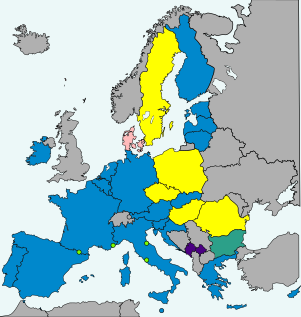
- European Union member states (special territories not shown)
- 20 in the eurozone1 in ERM II, with an opt-out (Denmark)5 not in ERM II, but obliged to join the eurozone on meeting the convergence criteria (Czech Republic, Hungary, Poland, Romania, and Sweden)
- Non–EU member states
Latvia replaced its previous currency, the lats, with the euro on 1 January 2014,[1] after a European Union (EU) assessment in June 2013 asserted that the country had met all convergence criteria necessary for euro adoption. The adoption process began 1 May 2004, when Latvia joined the European Union, entering the EU's Economic and Monetary Union. At the start of 2005, the lats was pegged to the euro at Ls 0.702804 = €1, and Latvia joined the European Exchange Rate Mechanism (ERM ll), four months later on 2 May 2005.[2]
History
[edit]Latvia's Treaty of Accession to the European Union (EU) obliged it to eventually adopt the euro. Latvia had originally planned to adopt the euro on 1 January 2008, but for various reasons this was subsequently delayed several times.[3][4] After being elected in 2011, Latvian President Andris Bērziņš announced the official goal was for Latvia to join the eurozone in 2014, saying "personally I'm very optimistic we'll join the euro on 1 January 2014. It's our goal and we are working hard to implement this process."[5] In September 2012, Latvian Prime Minister Valdis Dombrovskis reiterated that "Latvia is on track for 2014 and permission to join would be sought in 2013."[6][7]
Convergence
[edit]Before Latvia could adopt the euro, it had to meet five convergence criteria set by the EU. An assessment by the European Central Bank (ECB) in April 2012 found that Latvia met three of the five criteria. The Latvian Finance Minister announced in December 2012 that since convergence checks were only conducted biennially, an extraordinary report would be requested in February 2013,[8] but in January 2013 Prime Minister Dombrovskis stated that for "technical reasons" the request had been delayed until March. However, he was confident that Latvia was "fulfilling the Maastricht euro adoption criteria with a considerable reserve, therefore I don't see any basis on which this convergence report would be negative."[9] The Latvian government formally applied for a convergence check at the beginning of March,[10] and the resulting convergence report, published on 5 June 2013 by the European Commission, concluded that "the Commission considers that Latvia fulfils the conditions for the adoption of the euro."[11] The ECB simultaneously published a report which noted that "Latvia is within the reference values of the convergence criteria".[12] Latvia's adoption of the euro, a legal obligation now that the convergence criteria have been met, was given final approval by the Economic and Financial Affairs Council on 9 July,[13][14][15] and the lats was replaced with the euro on 1 January 2014.[1] The Euro switchover ceremony took place at a site where Latvia's crisis began – the former headquarters of the collapsed Parex bank, now headquarters of state-owned Citatele bank, which emerged from Parex's ruins.[16]
Status
[edit]| Assessment month | Country | HICP inflation rate[17][nb 1] | Excessive deficit procedure[18] | Exchange rate | Long-term interest rate[19][nb 2] | Compatibility of legislation | ||
|---|---|---|---|---|---|---|---|---|
| Budget deficit to GDP[20] | Debt-to-GDP ratio[21] | ERM II member[22] | Change in rate[23][24][nb 3] | |||||
| 2012 ECB Report[nb 4] | Reference values | Max. 3.1%[nb 5] (as of 31 Mar 2012) |
None open (as of 31 March 2012) | Min. 2 years (as of 31 Mar 2012) |
Max. ±15%[nb 6] (for 2011) |
Max. 5.80%[nb 7] (as of 31 Mar 2012) |
Yes[25][26] (as of 31 Mar 2012) | |
| Max. 3.0% (Fiscal year 2011)[27] |
Max. 60% (Fiscal year 2011)[27] | |||||||
| 4.1% | Open | 6 years, 11 months | 0.3% | 5.77% | No | |||
| 3.5% | 42.6% | |||||||
| 2013 ECB Report[nb 8] | Reference values | Max. 2.7%[nb 9] (as of 30 Apr 2013) |
None open (as of 30 Apr 2013) | Min. 2 years (as of 30 Apr 2013) |
Max. ±15%[nb 6] (for 2012) |
Max. 5.5%[nb 9] (as of 30 Apr 2013) |
Yes[28][29] (as of 30 Apr 2013) | |
| Max. 3.0% (Fiscal year 2012)[30] |
Max. 60% (Fiscal year 2012)[30] | |||||||
| 1.3% | Open (Closed in June 2013) | 8 years | 1.3% | 3.84% | Yes | |||
| 1.2% | 40.7% | |||||||
- Notes
- ^ The rate of increase of the 12-month average HICP over the prior 12-month average must be no more than 1.5% larger than the unweighted arithmetic average of the similar HICP inflation rates in the 3 EU member states with the lowest HICP inflation. If any of these 3 states have a HICP rate significantly below the similarly averaged HICP rate for the eurozone (which according to ECB practice means more than 2% below), and if this low HICP rate has been primarily caused by exceptional circumstances (i.e. severe wage cuts or a strong recession), then such a state is not included in the calculation of the reference value and is replaced by the EU state with the fourth lowest HICP rate.
- ^ The arithmetic average of the annual yield of 10-year government bonds as of the end of the past 12 months must be no more than 2.0% larger than the unweighted arithmetic average of the bond yields in the 3 EU member states with the lowest HICP inflation. If any of these states have bond yields which are significantly larger than the similarly averaged yield for the eurozone (which according to previous ECB reports means more than 2% above) and at the same time does not have complete funding access to financial markets (which is the case for as long as a government receives bailout funds), then such a state is not to be included in the calculation of the reference value.
- ^ The change in the annual average exchange rate against the euro.
- ^ Reference values from the ECB convergence report of May 2012.[25]
- ^ Sweden, Ireland and Slovenia were the reference states.[25]
- ^ a b The maximum allowed change in rate is ± 2.25% for Denmark.
- ^ Sweden and Slovenia were the reference states, with Ireland excluded as an outlier.[25]
- ^ Reference values from the ECB convergence report of June 2013.[28]
- ^ a b Sweden, Latvia and Ireland were the reference states.[28]
Failed calls for a referendum
[edit]Some members of Latvia's parliament, the Saeima, originally pushed for a referendum on euro adoption,[34] but Latvian Prime Minister Valdis Dombrovskis argued that a referendum is unnecessary because Latvians already voted in favour of their EU accession treaty in 2003, which binds them to adopt the euro as soon as the country is found to comply with all the convergence criteria. He argued that, given the legal obligation, a referendum could only serve to delay or prevent euro adoption.[35] According to Latvian law, if more than 1/3 of all members of parliament object to a bill, and propose an alternative bill within two weeks of the original bill being passed by parliament, a referendum can be called to allow the public to decide between the two bills. On 31 January 2013, the Latvian parliament passed its "euro adoption bill". Four days later, the biggest opposition party, Harmony Center, stated that it would not support the alternative "referendum bill", which was tabled by the other opposition party, Union of Greens and Farmers.[36] Shortly after this, on 9 February, the referendum proposal had only gathered the support of 4 out of the Saeima's 100 members. These MPs stated that they would turn to the last remaining legal option to force a referendum: gathering a petition of at least 30,000 electoral signatories.[37] Latvia officially requested an extraordinary convergence report to assess their readiness for euro adoption on 4 March 2013.[38] Latvia's Central Election Commission rejected the proposed referendum on 18 March, as the proposed bill was considered not to comply with the Latvian constitution or Latvia's international obligations.[39]
Roadmap for euro adoption
[edit]A draft law outlining the euro switchover process was presented by the government's cabinet on 6 November 2012. It specified that:
- ATMs would stop distributing Lats from 1 January 2014.
- Both Lats and Euros would be in circulation for two weeks.
- Post offices would offer free exchange for a month (this was later extended to three months[40]).
- All shops would be required to have dual price displays for three months before and until six months after the adoption.[41]
The law was passed on 31 January 2013.[9][42]
| Euro adoption day | Changeover plan | Introduction[43] | Frontloading | Dual circulation period |
Exchange of LVL coins period | Dual price display | Mint company | Currency circulated (in units) |
|---|---|---|---|---|---|---|---|---|
| 1 January 2014 | A changeover law was passed 31 Jan 2013[9][40] | Big-Bang | Bank and credit institutions starts receiving euro banknotes and coins 2 months before €-day. Retailers also receive coins and banknotes ahead of €-day, between 10 and 27 Dec.2013.[44] |
2 weeks | Post-offices: 3 months Banks: 6 months Central bank: Indefinitely |
1 October 2013 until 30 June 2014 | Stuttgart Mint[45] | 87 million banknotes and 400 million coins[46] |
Linguistic issues
[edit]
The Latvian Parliament adopted on 26 July 2005 "Regulation Nr.564", outlining that the official Latvian name of the euro currency would be "eiro". In December 2007 the regulation was amended, so that the name in all legal matters would be "euro" and in all non-legal matters "eiro". The ECB was asked to approve this special naming convention, but declined on 13 November 2012 and asked Latvia to repeal either the entire regulation or at least the paragraph that granted the euro currency a special Latvian name.[47] On 4 March 2013, the Latvian Ministry of Justice clarified that while the official name of the currency for all financial and legal documents shall be "euro", the public will continue to be able to use the Latvian name "eiro", furthermore it is required to write "euro" in italics indicating the word is in a foreign language.[48]
Latvian euro design
[edit]Latvian euro coins feature three separate designs on the national side,[49] which were publicised in July 2006 on the home page of the National Bank of Latvia. The designs featured were the Latvian maiden, which was featured on the 5 lats coin prior to World War II, on the 1 and 2 euro coins, the greater coat of arms of Latvia on the 10, 20 and 50-cent coins, and the lesser Coat of arms of Latvia on the 1, 2 and 5-cent coins. Originally, it was planned that the Freedom Monument would be featured on the 2 euro coin, but the original design did not meet the regulations of the ECB since it reached out into the ring of the coin and changed one of the stars. Latvia decided that a changed design of the monument would not be as recognisable and decided to use the Latvian maiden, used on the 1 euro coin, on the 2 euro coin as well.[50]
For the design of images on the common side and a detailed description of the coins, see euro coins.
| €0.01 | €0.02 | €0.05 |
|---|---|---|
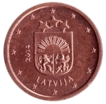
|
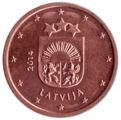
|
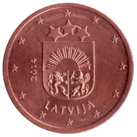
|
| Lesser coat of arms of Latvia | ||
| €0.10 | €0.20 | €0.50 |
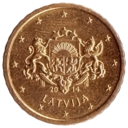
|

|
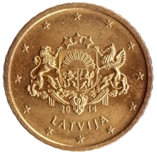
|
| Greater coat of arms of Latvia | ||
| €1.00 | €2.00 | €2 Coin Edge |

|

|
|
| Latvian maiden | ||
A tender for minting the Latvian euro coins began on 20 September 2012.[46][51] On 10 December 2012, it was announced that Latvia will utilise the Baden-Württemberg Mint.[45][52] The coins were minted in Stuttgart except the 1 cent, 10 cent and 1 euro coins, which were minted in Karlsruhe. The production of Latvian euros began in July 2013.[53]
Latvian Historical Regions series
[edit]| Year | Number | Design |
|---|---|---|
| 2016 | 1 | Vidzeme's coat of arms |
| 2017 | 2 | Courland's coat of arms |
| 2017 | 3 | Latgale's coat of arms |
| 2018 | 4 | Semigallia's coat of arms |
Circulating mintage quantities
[edit]| Face Value | €0.01 | €0.02 | €0.05 | €0.10 | €0.20 | €0.50 | €1.00 | €2.00 | €2.00 CC | Total |
|---|---|---|---|---|---|---|---|---|---|---|
| 2014 | 120,000,000 | 80,000,000 | 50,000,000 | 40,000,000 | 35,000,000 | 25,000,000 | 30,000,000 | 20,000,000 | 1,000,000 | 401,000,000 |
| 2015 | * | * | * | * | * | * | * | * | * | * |
| 2016 | * | * | * | * | * | * | * | 10,000,000 | * | 10,000,000 |
| 2017 | * | * | * | * | * | * | * | * | * | * |
| 2018 | * | * | * | * | * | * | * | * | * | * |
| 2019 | * | * | 15,000,000 | * | * | * | * | * | * | 15,000,000 |
| 2020 | * | * | * | * | * | * | * | * | * | * |
| 2021 | * | * | * | * | * | * | * | * | * | * |
| 2022 | * | * | * | * | * | * | * | * | * | * |
| 2023 | * | * | 15,000,000 | * | * | * | * | * | * | 15,000,000 |
|
* No coins were minted that year for that denomination | ||||||||||
Mints
[edit]2014: Germany (Stuttgart): 2 cent, 5 cent, 20 cent, 50 cent, 2 euro.
2014: Germany (Karlsruhe): 1 cent, 10 cent, 1 euro.
2015-2018: Germany (Stuttgart)
References
[edit]- ^ a b "Latvia becomes the 18th Member State to adopt the euro". European Commission. 31 December 2013. Retrieved 31 December 2013.
- ^ "ECB: Euro central rates and compulsory intervention rates in ERM II". European Central Bank. 2 May 2005. Retrieved 1 January 2014.
- ^ "Don't look for the Euro until after 2012". New Europe. 18 August 2007. Archived from the original on 23 December 2007. Retrieved 27 December 2007.
- ^ "Bank targets 2013 as Latvia's 'E-day'". baltictimes.com. 26 October 2007. Retrieved 28 October 2007.
- ^ Pop, Valentina (15 September 2011). "Latvia aiming to join eurozone in 2014". EU Observer. Retrieved 15 September 2011.
- ^ Latvia still keen to join single currency despite euro crisis, Guardian 19 September 2012
- ^ "Latvia on track to join euro in 2014, says PM". EU Observer. 22 October 2012. Retrieved 22 October 2012.
- ^ "INTERVIEW: Latvia to apply to join euro zone in February 2013". Reuters Middle East. 18 December 2012. Retrieved 24 January 2013.
- ^ a b c "Latvian parliament paves way to euro switch". EurActiv. 1 February 2013. Retrieved 3 February 2013.
- ^ "Latvia and the euro". European Commission. 5 March 2013. Retrieved 31 March 2013.
- ^ "Convergence Report 2013 on Latvia". European Commission. June 2013. Retrieved 16 June 2013.
- ^ "Convergence Report" (PDF). European Central Bank. June 2013. Retrieved 16 June 2013.
- ^ "Press release - 3252nd Council meeting - Economic and Financial Affairs" (PDF). Council of the European Union. 9 July 2013. Retrieved 23 January 2014.
- ^ "Commission: Latvia meets the conditions for adopting the euro". European Commission. 5 June 2013. Retrieved 16 June 2013.
- ^ "Latvia Wins Final EU Approval to Adopt Euro on Jan. 1 Next Year". Bloomberg. 9 July 2013. Retrieved 9 July 2013.
- ^ "Latvia caps years of austerity with euro zone membership". Euronews. 1 January 2014. Retrieved 5 January 2014.
- ^ "HICP (2005=100): Monthly data (12-month average rate of annual change)". Eurostat. 16 August 2012. Retrieved 14 March 2024.
- ^ "The corrective arm/ Excessive Deficit Procedure". European Commission. Retrieved 14 March 2024.
- ^ "Long-term interest rate statistics for EU Member States (monthly data for the average of the past year)". Eurostat. Retrieved 18 December 2012.
- ^ "Government deficit/surplus, debt and associated data". Eurostat. 22 April 2013. Retrieved 22 April 2013.
- ^ "General government debt". Eurostat. Retrieved 2 June 2018.
- ^ "ERM II – the EU's Exchange Rate Mechanism". European Commission. Retrieved 14 March 2024.
- ^ "Euro/ECU exchange rates - annual data". Eurostat. Retrieved 14 March 2024.
- ^ "Former euro area national currencies vs. euro/ECU - annual data". Eurostat. Retrieved 14 March 2024.
- ^ a b c d "Convergence Report May 2012" (PDF). European Central Bank. May 2012. Retrieved 20 January 2013.
- ^ "Convergence Report - 2012" (PDF). European Commission. March 2012. Retrieved 26 September 2014.
- ^ a b "European economic forecast - spring 2012" (PDF). European Commission. 1 May 2012. Retrieved 1 September 2012.
- ^ a b c "Convergence Report" (PDF). European Central Bank. June 2013. Retrieved 17 June 2013.
- ^ "Convergence Report - 2013" (PDF). European Commission. March 2013. Retrieved 26 September 2014.
- ^ a b "European economic forecast - spring 2013" (PDF). European Commission. February 2013. Retrieved 4 July 2014.
- ^ "Luxembourg Report prepared in accordance with Article 126(3) of the Treaty" (PDF). European Commission. 12 May 2010. Retrieved 18 November 2012.
- ^ "EMI Annual Report 1994" (PDF). European Monetary Institute (EMI). April 1995. Retrieved 22 November 2012.
- ^ a b "Progress towards convergence - November 1995 (report prepared in accordance with article 7 of the EMI statute)" (PDF). European Monetary Institute (EMI). November 1995. Retrieved 22 November 2012.
- ^ Duxbury, Charles (28 February 2013). "Lithuania's New Leader Says Nation Wants Euro". The Wall Street Journal. Retrieved 3 March 2013.
However, some Latvian lawmakers recently sought a referendum on that country's move
- ^ "If opposition initiates referendum on euro, Latvia will fall behind euro introduction timetable". 10 December 2012. Retrieved 3 March 2013.
- ^ "Latvia's Biggest Opposition Party Won't Seek Referendum on Euro". Bloomberg L.P. 4 February 2013. Retrieved 6 March 2013.
- ^ "Four members calls for the suspension of the Euro Law, however, the President will enact the law" (in Latvian). Delfi.lv. 8 February 2013. Retrieved 6 March 2013.
- ^ "Latvia formally applies for eurozone membership". Euractiv.com. 4 March 2013. Retrieved 4 March 2013.
- ^ "CEC decided not to register the proposed referendum bill about the introduction of the euro" (in Latvian). Delfi.lv. 18 March 2013. Retrieved 18 March 2013.
- ^ a b "Saeima adopted the euro Law". Saeima. 31 January 2013. Retrieved 16 February 2013.
- ^ "Latvia on Road to Adopt Euro in 2014". Sofia News Agency. 7 November 2012. Retrieved 7 November 2012.
- ^ "Introduction of the euro Law (No: 459/Lp11)". Saeima. 16 November 2012. Retrieved 30 November 2012.
- ^ "Scenarios for adopting the euro". Ec.europa.eu/. Retrieved 7 September 2013.
- ^ "The introduction of the euro in Latvia" (PDF). European Commission. 8 April 2014.
- ^ a b "Latvian euro coins Kal Germany for 5.306 million" (in Latvian). FinanceNet. 10 December 2012. Retrieved 21 December 2012.
- ^ a b "Bank of Latvia Announces Tender to Mint Euro Coins for Latvia". Latvia Today. 27 September 2012. Archived from the original on 2 December 2013. Retrieved 27 October 2012.
- ^ "OPINION OF THE EUROPEAN CENTRAL BANK: On the spelling of the single currency (CON/2012/87)" (PDF). European Central Bank. 13 November 2012. Retrieved 6 March 2013.
- ^ "Society and public space will continue to be able to use the word "eiro"" (in Latvian). Latvian Ministry of Justice. 4 March 2013. Archived from the original on 12 May 2013. Retrieved 6 March 2013.
- ^ "The Origins of Euro Coins: Latvia". National Bank of Latvia. Archived from the original on 10 April 2009. Retrieved 12 July 2008.
- ^ "Latvian Euro Coins". eiro.lv. Retrieved 25 January 2013.
- ^ "Tender Regulation: On the Potential Production, Packaging and Delivery of the Latvian Euro Circulation Coins (Amended by Resolution of Minutes no.3 meeting)" (PDF). Bank of Latvia. 20 November 2012. Retrieved 30 November 2012.[permanent dead link]
- ^ "The Design Models of the Latvian Euro Coins". Bank of Latvia. Archived from the original on 27 June 2013. Retrieved 18 July 2013.
- ^ "Vācijā sākta Latvijas eiro monētu kalšana". 31 July 2013. Retrieved 23 November 2013.

